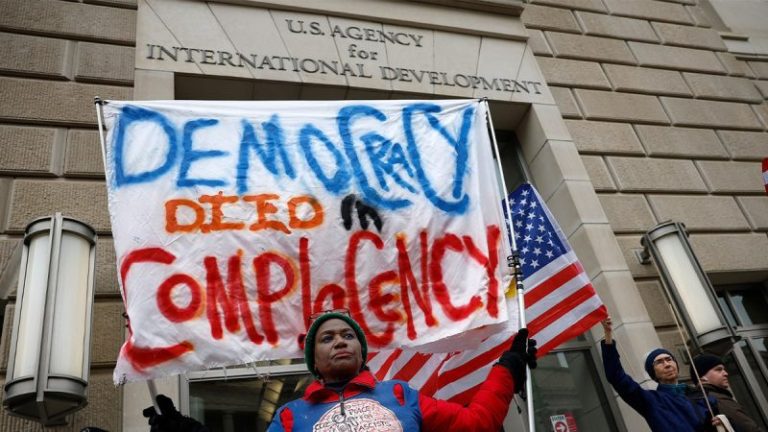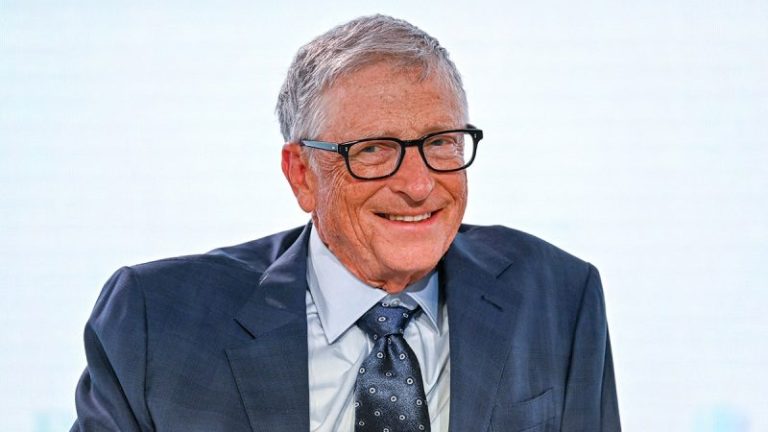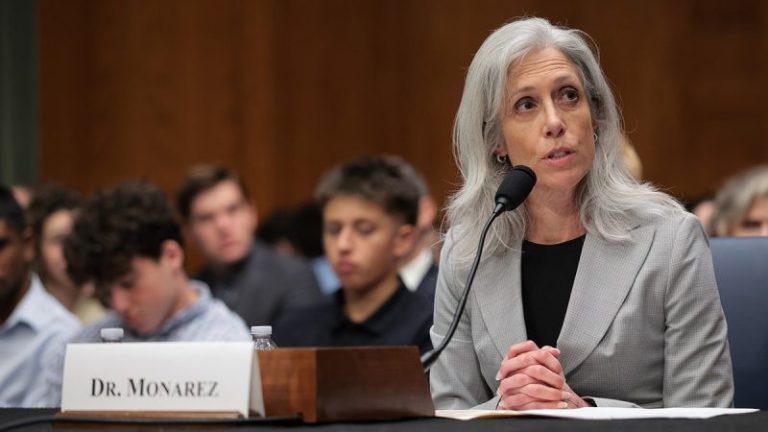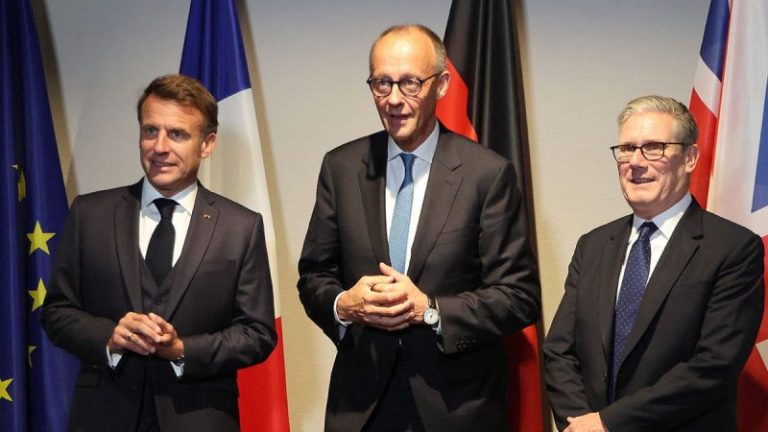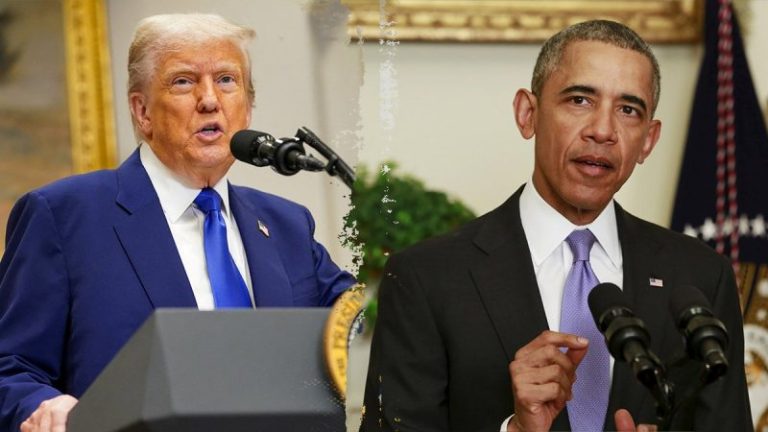Newly declassified documents have stated that former President Barack Obama was present for key meetings with his top intelligence and national security officials that led to critical steps in the opening of the Trump–Russia investigation.
Director of National Intelligence Tulsi Gabbard and CIA Director John Ratcliffe have declassified new documents related to the origins of the original Trump–Russia probe at the FBI — known inside the bureau as ‘Crossfire Hurricane.’
Trump has accused Obama of being the ‘ringleader’ of the Russiagate narrative — an allegation vehemently denied by the former president.
‘Out of respect for the office of the presidency, our office does not normally dignify the constant nonsense and misinformation flowing out of this White House with a response,’ Obama spokesman Patrick Rodenbush said in a July statement. ‘But these claims are outrageous enough to merit one.’
‘These bizarre allegations are ridiculous and a weak attempt at distraction,’ Obama’s spokesman continued. ‘Nothing in the document issued last week undercuts the widely accepted conclusion that Russia worked to influence the 2016 presidential election but did not successfully manipulate any votes.’
He added: ‘These findings were affirmed in a 2020 report by the bipartisan Senate Intelligence Committee, led by then-Chairman Marco Rubio.’
Here’s a look at the known key meetings the former president attended and was reportedly made aware of:
Aug. 3, 2016
On Aug. 3, 2016, then-CIA Director John Brennan reportedly briefed then-President Obama on intelligence that then-Democratic nominee former Secretary of State Hillary Clinton allegedly was stirring up a plan to tie Trump to Russia.
Then-Vice President Joe Biden, then-FBI Director James Comey, then-Attorney General Loretta Lynch and then-Director of National Intelligence James Clapper also were reportedly present for the briefing.
Brennan’s notes from that briefing were declassified in 2020 by John Ratcliffe, who, at the time, was serving as director of National Intelligence. Ratcliffe is now the director of the CIA.
Fox News Digital, at the time, exclusively reported on those notes.
‘We’re getting additional insight into Russian activities from (REDACTED),’ Brennan notes read. ‘CITE (summarizing) alleged approved by Hillary Clinton a proposal from one of her foreign policy advisers to vilify Donald Trump by stirring up a scandal claiming interference by the Russian security service.’
The notes state ‘on 28 of July.’ In the margin, Brennan writes ‘POTUS,’ but that section of the notes is redacted.
‘Any evidence of collaboration between Trump campaign + Russia,’ the notes read.
The remainder of the notes are redacted, except in the margins, which reads: ‘JC,’ ‘Denis,’ and ‘Susan.’
The notes don’t spell out the full names but ‘JC’ could be referring to then-FBI Director James Comey or former Director of National Intelligence James Clapper. ‘Susan’ could refer to National Security Adviser Susan Rice. And ‘Denis’ could possibly refer to then-Obama chief of staff Denis McDonough.
The meeting came just days after the FBI, July 31, 2016, opened a counterintelligence investigation into whether candidate Trump and members of his campaign were colluding or coordinating with Russia to influence the 2016 campaign. It was opened by then-Deputy Assistant Director for Counterintelligence Peter Strzok.
Days after that briefing, the CIA properly forwarded that information through a Counterintelligence Operational Lead (CIOL) to Comey and Strzok, with the subject line: ‘Crossfire Hurricane.’
Fox News Digital exclusively obtained and reported on the CIOL in October 2020, which stated: ‘The following information is provided for the exclusive use of your bureau for background investigative action or lead purposes as appropriate.’
‘Per FBI verbal request, CIA provides the below examples of information the CROSSFIRE HURRICANE fusion cell has gleaned to date,’ the memo continued. ‘An exchange (REDACTED) discussing US presidential candidate Hillary Clinton’s approval of a plan concerning US presidential candidate Donald Trump and Russian hackers hampering US elections as a means of distracting the public from her use of a private email server.’
But days before the Aug. 3, 2016, briefing, and before the July 31, 2016, opening of the Crossfire Hurricane probe, foreign sources allegedly connected to left-wing billionaire George Soros were emailing about the FBI opening a probe into the salacious Trump–Russia narrative.
That information came from emails dated July 25, 2016, to July 27, 2016, contained in the newly declassified appendix of Special Counsel John Durham’s report.
The appendix reveals that the foreign sources were allegedly tied to George Soros’ Open Society Foundations.
The appendix said that Russian government actors in 2016 reportedly hacked emails from the Open Society Foundations, formerly known as the Soros Foundation.
‘Two of the apparently hacked emails appear to have originated from the Open Society Foundations,’ the appendix states, noting that the purported author of these emails was Leonard Benardo, who was the regional director for Eurasia at the Open Society Foundations.
‘During the first stage of the campaign, due to lack of direct evidence, it was decided to disseminate the necessary information through the FBI-affiliated…technical structures… in particular, the Crowdstrike and ThreatConnect companies, from where the information would then be disseminated through leading U.S. publications,’ Benardo reportedly wrote in an email, per the appendix.
‘The media analysis on the DNC hacking appears solid …. Julie (Clinton Campaign Advisor) says it will be a long-term affair to demonize Putin and Trump. Now it is good for a post-convention bounce,’ Benardo allegedly wrote, per the appendix. ‘Later the FBI will put more oil into the fire.’
Another email reportedly from Benardo on July 27, 2016, states: ‘HRC (Hillary Rodham Clinton) approved Julie’s idea about Trump and Russian hackers hampering U.S. elections.’
‘This should distract people from her own missing email, especially if the affair goes to the Olympic level,’ Benardo reportedly continued, per the annex. ‘The point is making the Russian play a U.S. domestic issue. Say something like a critical infrastructure threat for the election to feel manic since both POTUS and VPOTUS have acknowledge the fact IC would speed up searching for evidence that is regrettably still unavailable.’
Crossfire Hurricane, the FBI’s Trump–Russia investigation, was opened just several days later, on July 31, 2016. And Brennan briefed Obama just days after that.
It is unclear if the Benardo emails were part of the Aug. 3, 2016, briefing.
Nov. 10, 2016
Then-President Obama invited then-President-elect Donald Trump to the White House just two days after the 2016 presidential election.
During that meeting, Obama warned Trump against hiring Michael Flynn to serve as his White House national security adviser.
Flynn, a critic of the Obama administration, had been fired as head of military intelligence by Obama in 2014.
Trump tapped Flynn for the post anyway, but Flynn resigned less than a month into his tenure after reports that he had misled then-Vice President Mike Pence about his conversations with Russia’s ambassador to the United States, Sergey Kislyak.
Flynn ended up being a key figure in the early days of Russiagate.
As part of former Special Counsel Robert Mueller’s investigation, Flynn pleaded guilty to making false statements in his FBI interview regarding his talks with Kislyak. Flynn was charged with lying to federal investigators about whether he had talked to Kislyak about limiting the Russian government’s response to Obama’s sanctions for election meddling.
His plea deal involved his full cooperation with investigators in the special counsel’s office.
But FBI agents did not actually believe that Flynn intentionally lied about his talks with Kislyak.
In 2020, the Justice Department dropped its case against Flynn, shortly after internal memos were released that raised serious questions about the nature of the investigation that led to the guilty plea for lying to the FBI.
Those documents showed how agents discussed their motivations for interviewing him in the Russia probe — questioning whether they wanted to ‘get him to lie’ so he’d be fired or prosecuted, or get him to admit wrongdoing. Flynn allies howled over the revelations, arguing that he was essentially set up in a perjury trap.
Declassified notes showed agents considered various options in the run-up to their fateful January 2017 interview with Flynn, including getting Flynn ‘to admit to breaking the Logan Act’ when he spoke to Kislyak during the presidential transition period.
‘What is our goal?’ one of the notes read. ‘Truth/Admission or to get him to lie, so we can prosecute him or get him fired?’
Another note read, ‘If we get him to admit to breaking the Logan Act, give facts to DOJ + have them decide.’
The memo appeared to weigh the pros and cons of pursuing those different paths, while cautioning: ‘If we’re seen as playing games, WH (White House) will be furious.’
Flynn’s communications with Kislyak in December 2016 had been picked up in wiretapped discussions, apparently unbeknownst to him. The FBI agents in January 2017 questioned him on the communications and later used his answers to form the basis for the false-statement charge and his guilty plea.
Flynn had moved to withdraw his guilty plea for lying to the FBI in the Russia probe, citing ‘bad faith’ by the government. That court filing came just days after the Justice Department reversed course to recommend up to six months of prison time in his case, alleging he was not fully cooperating or accepting responsibility for his actions.
The case had been plodding through the court system with no resolution ever since his original plea, even amid speculation about whether Trump himself could extend a pardon.
Trump, in May 2020, said Flynn was a target of the Obama administration and called the investigation into his former national security adviser treasonous.
‘They’re human scum,’ Trump said. ‘It’s treason.’
Dec. 9, 2016
Current Director of National Intelligence Gabbard recently declassified documents claiming that the Obama administration ‘manufactured and politicized intelligence’ to allegedly create the narrative that Russia was attempting to influence the 2016 presidential election, despite information from the intelligence community stating otherwise.
Documents revealed that in the months leading up to the November 2016 election, the intelligence community consistently assessed that Russia was ‘probably not trying…to influence the election by using cyber means.’
One instance was Dec. 7, 2016, weeks after the election.
Then-Director of National Intelligence Clapper’s talking points stated: ‘Foreign adversaries did not use cyberattacks on election infrastructure to alter the U.S. presidential election outcome.’
Fox News Digital obtained a declassified copy of the Presidential Daily Brief, which was prepared by the Department of Homeland Security, with reporting from the CIA, Defense Intelligence Agency, FBI, National Security Agency, Department of Homeland Security, State Department and open sources, for Obama, dated Dec. 8, 2016.
‘We assess that Russian and criminal actors did not impact recent US election results by conducting malicious cyber activities against election infrastructure,’ the Presidential Daily Brief stated. ‘Russian Government-affiliated actors most likely compromised an Illinois voter registration database and unsuccessfully attempted the same in other states.’
But the brief stated that it was ‘highly unlikely’ the effort ‘would have resulted in altering any state’s official vote result.’
‘Criminal activity also failed to reach the scale and sophistication necessary to change election outcomes,’ it stated.
The brief noted that the Office of the Director of National Intelligence assessed that any Russian activities ‘probably were intended to cause psychological effects, such as undermining the credibility of the election process and candidates.’
The brief stated that cyber criminals ‘tried to steal data and to interrupt election processes by targeting election infrastructure, but these actions did not achieve a notable disruptive effect.’
Fox News Digital obtained declassified, but redacted, communications from the FBI on the Presidential Daily Brief, stating that it ‘should not go forward until the FBI’ had shared its ‘concerns.’
Those communications revealed that the FBI allegedly drafted a ‘dissent’ to the original Presidential Daily Brief.
The communications revealed that the brief was expected to be published Dec. 9, 2016, the following day, but later communications revealed that Office of the Director of National Intelligence, ‘based on some new guidance,’ decided to ‘push back publication’ of the Presidential Daily Brief.
‘It will not run tomorrow and is not likely to run until next week,’ wrote the deputy director of the Presidential Daily Brief at Office of the Director of National Intelligence, whose name is redacted.
The following day, Dec. 9, 2016, a meeting convened in the White House Situation Room, with the subject line starting: ‘Summary of Conclusions for PC Meeting on a Sensitive Topic (REDACTED.)’
The meeting included top officials in the National Security Council, Clapper, Brennan, Rice, then-Secretary of State John Kerry, Lynch, then-Deputy FBI Director Andrew McCabe, among others, to discuss Russia.
The declassified meeting record, obtained by Fox News Digital, revealed that principals ‘agreed to recommend sanctioning of certain members of the Russian military intelligence and foreign intelligence chains of command responsible for cyber operations as a response to cyber activity that attempted to influence or interfere with U.S. elections, if such activity meets the requirements’ from an executive order that demanded the blocking of property belonging to people engaged in cyber activities.
After the meeting, according to the Office of the Director of National Intelligence, Clapper’s executive assistant reportedly emailed intelligence community leaders tasking them to create a new intelligence community assessment ‘per the president’s request,’ that detailed the ‘tools Moscow used and actions it took to influence the 2016 election.’
‘ODNI will lead this effort with participation from CIA, FBI, NSA, and DHS,’ the record states.
Later, Obama officials allegedly ‘leaked false statements to media outlets’ claiming that ‘Russia has attempted through cyber means to interfere in, if not actively influence, the outcome of an election.’
By Jan. 6, 2017, a new Intelligence Community Assessment was released that, according to the Office of the Director of National Intelligence, ‘directly contradicted the IC assessments that were made throughout the previous six months.’
Jan. 5, 2017
Then-President Obama held an Oval Office meeting Jan. 5, 2017, with then-FBI Director James Comey, then-National Security Adviser Susan Rice, then-CIA Director John Brennan, then-Director of National Intelligence James Clapper and then-Vice President Joe Biden.
During that meeting, Comey reportedly suggested to Obama that the National Security Council might not want to pass ‘sensitive information related to Russia’ to then-incoming National Security Adviser Michael Flynn.
On Jan. 20, 2017, the day Trump was first inaugurated, Rice sent herself an email documenting the Jan. 5, 2017, Oval Office meeting. That email was declassified by former acting Director of National Intelligence Richard Grenell in 2020.
During that meeting, Comey provided guidance on how law enforcement needed to investigate Russian interference in the 2016 presidential race.
Comey reportedly told Obama he was proceeding with the Trump–Russia probe ‘by the book,’ and went on to discuss concerns about Flynn’s known conversation with Kilsyak.
Rice, in her email to self, wrote: ‘From a national security perspective, Comey said he does have some concerns that incoming NSA Flynn is speaking frequently with Russian Ambassador (Sergey) Kislyak. Comey said that could be an issue as it relates to sharing sensitive information. President Obama asked if Comey was saying that the NSC should not pass sensitive information related to Russia to Flynn.’
Rice then wrote, ‘Comey replied, ‘potentially.’ He added that he has no indication thus far that Flynn has passed classified information to Kislyak, but he noted that ‘the level of communication is unusual.’’
When the email was declassified in 2020, a representative for Rice told Fox News Digital that ‘no discussion of law enforcement matters or investigations took place, despite accusations to the contrary.’
The spokeswoman also insisted the Obama administration did not change the way it briefed Flynn, saying Rice briefed Flynn for more than 12 hours on four separate occasions during the transition.
‘Ambassador Rice did not alter the way she briefed Michael Flynn on Russia as a result of Director Comey’s response,’ Rice representative Erin Pelton said.
‘President Obama began the conversation by stressing his continued commitment to ensuring that every aspect of this issue is handled by the intelligence and law enforcement communities ‘by the book,” Rice emailed to herself. ‘The president stressed that he is not asking about, initiating or instructing anything from a law enforcement perspective. He reiterated that our law enforcement team needs to proceed as it normally would by the book.’
The email also appeared to reflect Obama’s guidance on sharing sensitive information with both the Russians and the incoming Trump administration.
Rice wrote that Obama said, ‘He wants to be sure that, as we engage with the incoming team, we are mindful to ascertain if there is any reason that we cannot share information fully as it relates to Russia.’
Rice wrote: ‘The president asked Comey to inform him if anything changes in the next few weeks that should affect how we share classified information with the incoming team. Comey said he would.’
This post appeared first on FOX NEWS



